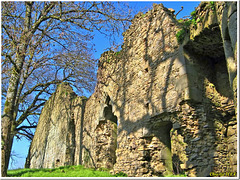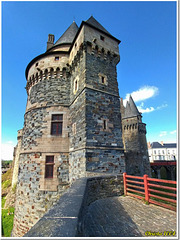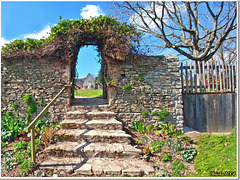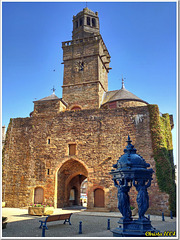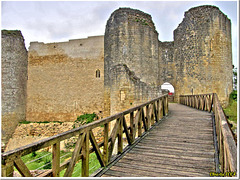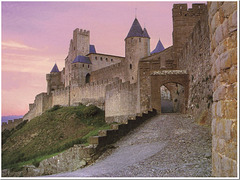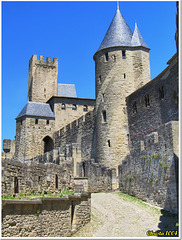
Remnants of the past
Small walk within big history - HFF.
| |
|
|
|
Going around the ramparts of the Upper Town of Granville is one of the things to do if you want to discover this city. From here you'll find a view of the different facets that make up the port city: from its oldest past, dating back to the Middle Ages, to today.
PETITE PROMENADE DANS LA GRANDE HISTOIRE. Faire le tour à pied des remparts de la Haute-Ville de Granville est une des choses à faire si on veut découvrir cette cité. D'ici, on a une vue sur les différentes facettes qui composent la cité portuaire : de son passé le plus ancien, remontant au Moyen-Âge, à aujourd'hui.
KLEINER SPAZIERGANG IN GROSSER GESCHICHTE. Die Stadtmauern der Oberstadt von Granville zu umgehen, ist etwas, das man machen sollte, wenn man diese Stadt entdecken will. Von hier aus hat man einen Blick auf die unter- schiedlichen Facetten, die die Hafenstadt ausmachen : von der ältesten Vergangenheit über das Mittelalter bis heute.
C'est du costaud, ça !
| |
|
|
|
La porte Saint-Mathurin est l'une des entrées de ce petit village fortifié, entouré d'une enceinte de murailles dont il reste d'importants vestiges. L'enceinte fortifié (12 et 13ème siècles) inclue la motte castrale, les ruines du donjon, les fossés et enceintes du bourg ainsi que les deux portes fortifiées dites de Saint-Rémy et Saint-Mathurin.
THAT'S REALLY STURDY! The gate of Saint-Mathurin is one of the entrances to this small fortified village surrounded by a wall of which there are significant remains. The fortified complex (12th and 13th C.) includes the castle hill, the ruins of the keep, the moats and fences of the village and the two fortified gates Saint-Rémy and Saint-Mathurin.
DAS IST ECHT STANDHAFT! Das Saint-Mathurin-Tor ist einer der Eingänge zu diesem kleinen befestigten Dorf, das von einer Mauer umgeben ist, von der bedeutende Überreste vorhanden sind. Die befestigte Anlage (12. und 13. Jh.) umfasst den Burghügel, die Ruinen des Bergfrieds, die Gräben und Einfriedungen des Dorfes sowie die beiden befestigten Tore Saint-Rémy und Saint-Mathurin.
Le temps est suspendu...
| |
|
|
|
... ce jour, le 19 août pour la Journée Mondiale de la Photographie, mais aussi à l'intérieur de cette vielle tour du 12ème siècle. L'horloge et les cloches témoignent du passé mais sont à jamais arrêtés. Ce sont les seules vestiges de l'ancienne église paroissiale Saint Georges (voir PiP) qui a été démolie en 1963, le clocher est tout ce qui reste.
TIME STANDS STILL... this day, August 19 for World Photography Day, but also inside this old 12th century bell tower. The clock and the bells testify to the past but are forever stopped. These are the only vestiges of the old parish church Saint Georges (see PIP) which was demolished in 1963, the bell tower is all what remains.
DIE ZEIT STEHT STILL ... am heutigen Tag, 19.August, zum Weltfotografietag, aber auch in diesem alten Glockenturm aus dem 12. Jh. Die Uhr und die Glocken zeugen von der Vergangenheit, stehen aber für immer still. Es sind die einzigen Reste der alten Pfarrkirche Saint Georges (siehe PIP), sie wurde 1963 abgerissen, der Turm ist alles, was übrig geblieben ist..
Le château de la Belle au bois dormant
| |
|
|
|
Le château du Rocher dont la construction a commencé au 13ème siècle se reflète dans les eaux d'un paisible étang. Il est hérissé de tours aux toits pointus et arbore sur sa façade principale une splendide galerie Renaissance à cinq arcades. Une vieille légende, celle de la Dame verte, raconte que le château serait régulièrement le témoin d'apparitions d'une dame vêtue de vert (la duchesse du Lude et ancienne propriétaire du domaine), une chasseresse impénitente condamnée à errer en ces lieux pour l'éternité…
SLEEPING BEAUTY'S CASTLE. The "Château du Rocher", construction of which began in the 13th C., is reflected in the waters of a quiet pond. It bristles with towers with pointed roofs, and features on its main facade a splendid Renaissance gallery with five arches. An old legend, that of the Green Lady, says that the castle would regularly witness the apparitions of a lady dressed in green (the Duchess of Lude and former owner of the estate), an unrepentant huntress condemned to wander around this place for eternity...
DORNRÖSCHENSCHLOSS. Das "Château du Rocher", dessen Bau im 13. Jh. begann, spiegelt sich im Wasser eines ruhigen Teiches. Es zeigt Türme mit Spitzdächern und weist an seiner Hauptfassade eine prächtige Renaissancegalerie mit fünf Bögen auf. Eine alte Legende, die der Grünen Dame, besagt, dass das Schloss regelmäßig die Erscheinungen einer grün gekleideten Dame (der Herzogin von Lude und ehemalige Besitzerin des Anwesens) erlebt, einer reuelosen Jägerin, die dazu verdammt ist, für die Ewigkeit an diesem Ort herum zu irren...
Joli lieu d'antan
| |
|
|
|
En face des halles on peut trouver cette vieille forge de 1750. Elle est toujours en activité, une trentaine de chevaux par an y sont ferrés. Pour rappeler l’existence d’une culture viticole à Saint-Denis-d’Anjou, un carré de vigne a été planté au pied de cette forge.
NICE PLACE OF YESTERYEAR. Opposite the market hall you can find this old forge from 1750. It is still active, around 30 horses a year are shoed there. To recall the existence of a wine culture in Saint-Denis-d'Anjou, a vineyard has been planted at the foot of this forge.
NETTER PLATZ VON FRÜHER. Gegenüber der Markthallen befindet sich diese alte Schmiede (1750). Sie ist immer noch aktiv, etwa 30 Pferde werden dort pro Jahr beschlagen. Um an die Existenz einer Weinkultur in Saint-Denis-d'Anjou zu erinnern, wurde am Fusse dieser Schmiede ein Weinberg angelegt.
In the narrow streets of the old village - HFF
| |
|
|
|
Saint-Denis-d'Anjou is the prettiest village in south Mayenne. It has kept its medieval character, with its narrow streets, its 15th and 16th century winegrowers mansions, its market hall built in 1509 and even an old forge that is still in operation. Until the 18th century, almost 600 hectares of vines surrounded the city before it was gradually destroyed by the spread of phylloxera. In order to perpetuate this know-how, one hectare of vineyards was replanted at the end of the 20th century: "Clos de la Morinière", a Chenin Blanc, is the only wine that is produced in Mayenne.
DANS LES RUELLES DU VIEUX VILLAGE. Saint-Denis-d'Anjou, le plus beau village du sud de la Mayenne a conservé son caractère médiéval avec ses ruelles étroites, ses maisons de vignerons et seigneuriales des XVe et XVIe siècles, ses halles construits en 1509 et même une ancienne forge encore en activité. Au XVIIIe siècle il y avait toujours près de 600 hectares de vigne entourant la cité avant de s’éteindre progressivement suite à la propagation du phylloxéra. A la fin du XXe siècle pour perpétuer à nouveau ce savoir-faire, un hectare de vigne a été replanté : le "Clos de la Morinière", un chenin blanc, est le seul vin produit en Mayenne.
IN DEN GASSEN DES ALTEN DORFES. Saint-Denis-d'Anjou ist das schönste Dorf im Süden der Mayenne. Es hat seinen mittelalterlichen Charakter bewahrt, mit seinen engen Gassen, seinen Winzer- und Herrenhäusern aus dem 15. und 16. Jh., seinen 1509 erbauten Markthallen und sogar einer alten Schmiede, die noch in Betrieb ist. Noch im 18. Jh umgaben fast 600 Hektar Weinberge die Stadt, bevor sie durch die Ausbreitung der Reblaus allmählich zerstört wurden. Um dieses Know-how wieder zu erneuern wurde Ende des 20. Jh. ein Hektar Rebfläche neu bepflanzt: "Clos de la Morinière", ein Chenin Blanc, ist der einzige Wein, der in Mayenne produziert wird.
Bienvenue/Welcome 2022
| |
|
|
|
"Pour faire avancer les choses, ne pas avoir peur d'aller vers l'autre, car nos racines peuvent aussi devenir des ailes". (Scan d'une photo argentique faite à Pompéi en 2002).
"To get things done, don't be afraid to go towards the other, because our roots can also become wings" . (Scan of an analog photo taken in Pompeii in 2002).
"Um die Dinge in Gang zu bringen, habt keine Angst, auf den anderen zuzugehen, denn unsere Wurzeln können auch zu Flügeln werden". (Scan eines analogen Fotos, geknipst 2002 in Pompeji).
Il était une fois un château...
| |
|
|
|
... dont il ne reste que des vestiges de cet important domaine médiéval : un donjon roman et une résidence seigneuriale du milieu du 13e siècle dont la grande salle possède encore des traces de son décor peint. Autrefois il était clos de fossés et douves, mais déjà au 17e siècle, il n'y avait plus que les ruines des murailles et un chêne imposant avait poussé dans la salle principale. On peut le voir encore aujourd'hui !
ONCE UPON A TIME THERE WAS A CASTLE of which only the remains of this large medieval estate remain: a Romanesque keep and a mid-13th century manor house, the great hall of which has retained traces of its painted decoration. In the past it was surrounded by a moat, but by the 17th century only the ruins of the walls remained and a large oak tree had grown in the great hall. It can still be seen today!
ES WAR EINMAL EINE BURG von der nur noch die Überreste dieses bedeutenden mittelalterlichen Anwesens übrig sind: ein romanischer Bergfried und ein Herrschaftssitz aus der Mitte des 13. Jh., dessen grosser Saal noch Spuren seines gemalten Dekors aufweist. Früher war sie von Wassergräben umgeben, aber schon im 17. Jh. waren nur noch die Mauerreste übrig, und im Hauptsaal war eine mächtige Eiche gewachsen. Sie ist noch heute zu sehen !
My castle fence for Friday :) HFF
| |
|
|
|
Ma clôture du château pour vendredi :) (château de Vitré)
Mein Burg-Zaun zum Freitag :) (Burg von Vitré)
It smells like spring ✿✿✿ - HFF
Il ne voulait pas disparaître, ce donjon...
| |
|
|
|
Édifié vers 1123 par Henri 1er Beauclerc, duc de Normandie et roi d'Angleterre (fils de Guillaume le Conquérant), Vire devient alors une des plus importantes places fortes de Normandie. Le château a été démantelé sur ordre de Richelieu en 1630. Les ruines du donjon quadrangulaire restent impressionnantes, notamment sa façade ouest avec ses puissant contreforts plat et ses trois niveau avec leurs baies, leurs cheminées et les traces des dispositifs de défense.
IT DIDN'T WANT TO DISAPPEAR, THIS KEEP... Built around 1123 by Henry I Beauclerc, Duke of Normandy and King of England (son of William the Conqueror), its construction made Vire one of the most significant strongholds in Normandy. The castle was dismantled by order of Richelieu in 1630. The ruins of the quadrangular keep remain impressive, notably its western façade with its powerful flat buttresses and its three levels with their windows, fireplaces and traces of defensive structures.
ER WOLLTE NICHT VERSCHWINDEN, DIESER BERGFRIED... 1123 von Heinrich I. Beauclerc, Herzog der Normandie und König von England (Sohn von Wilhelm dem Eroberer) erbaut, machte sie Vire zu einer der wichtigsten Festungen der Normandie. Die Burg wurde 1630 auf Befehl von Richelieu demontiert. Beeindruckend sind die Ruinen des viereckigen Bergfrieds, vor allem die Westfassade mit ihren mächtigen flachen Strebepfeilern und die drei Stockwerke mit ihren Fenstern, Schornsteinen und Spuren von Verteidigungsanlagen.
Bench with view of historic backdrop - HBM
| |
|
|
|
The "Porte Horloge" (clock gate) was built in the 13th C., at the same time as the ramparts designed to protect the prosperous city of Vire. It was the main gateway to Vire for several centuries. Until the 18th C, it had an inner gate, a portcullis and a drawbridge that allowed the crossing of the deep ditches that surrounded the town. The quadrangular tower was used as a lookout post and was raised at the end of the 15th century to accommodate a clock. The presence of public clocks in towns was still exceptional at the end of the Middle Ages and illustrates the importance of the towns that had them.
BANC AVEC VUE SUR COULISSE HISTORIQUE. La Porte Horloge est construite au XIIIe siècle, en même temps que les remparts destinés à protéger la cité prospère de Vire. Elle fut la principale porte d’entrée de Vire pendant plusieurs siècles. Elle possédait jusqu’au XVIIIe siècle, une porte intérieure, une herse et un pont levis qui permettait de franchir les fossés profonds qui entouraient la ville. La tour quadrangulaire servait de poste de guet fut surélevée à la fin du XVe siècle pour accueillir une horloge. La présence d'horloges publiques dans les villes était encore exceptionnelle à la fin du Moyen-Âge et illustre l'importance des cités qui en possédaient.
BANK MIT BLICK AUF HISTORISCHE KULISSE. Die "Porte Horloge" (Uhrentor) wurde im 13. Jh. zusammen mit den Stadtmauern errichtet, die die wohlhabende Stadt Vire schützen sollten. Sie war mehrere Jahrhunderte lang das wichtigste Eingangstor von Vire. Bis zum 18. Jh. besass sie ein inneres Tor, ein Fallgitter und eine Zugbrücke, mit der man die tiefen Gräben, die die Stadt umgaben, überqueren konnte. Der viereckige Turm diente als Wachturm und wurde Ende des 15. Jh. erhöht, um eine Uhr zu beherbergen. Das Vorhandensein von öffentlichen Uhren in Städten war im späten Mittelalter noch aussergewöhnlich und verdeutlicht die Bedeutung der Städte, die sie besassen.
Old porch from the 13th century - HBM
| |
|
|
|
The blooming lilac spreads his scent, the bright yellow rape fields as far as the eye can see - but a gray sky all week we spent in the Vienne department!
VIEUX PORCHE DU 13e SIECLE. Le lila fleuri embaume de son parfum, les champs de colza d'un jaune éclatant à perte de vue - mais un ciel gris toute la semaine que nous avons passé dans la Vienne !
ALTER TORBOGEN AUS DEM 13. JH. Der blühende Flieder verbreitet seinen Duft, knallgelbe Rapsfelder soweit das Auge reicht - aber ein grauer Himmel die ganze Woche über, die wir in der Vienne verbracht haben !
Voyage dans un autre temps
| |
|
|
|
Cette forteresse militaire a été construite au XIIe siècle par le seigneur de Gençay. Le roi de France Jean le Bon y fut emprisonné en 1356 par le Prince Noir. En 1840, elle fut sauvé de la destruction en la classant Monument Historique. Bâti sur un épéron rocheux, entre autres deux tours rondes et un châtelet d’entrée subsistent encore.
JOURNEY INTO ANOTHER TIME. This military fortress was built in the 12th century by the lord of Gençay. King Jean le Bon of France was imprisoned here in 1356 by the Black Prince. In 1840, it was saved from destruction by being listed as a historical monument. Built on a rocky spur, inter alia two round towers and an entrance châtelet still remain.
REISE IN EINE ANDERE ZEIT. Diese militärische Festung wurde im 12. Jh. von den Herren von Gençay erbaut. Der französische König Jean le Bon wurde hier 1356 vom Schwarzen Prinzen gefangen gehalten. 1840 wurde sie vor der Zerstörung bewahrt, indem sie unter Denkmalschutz gestellt wurde. Auf einem Felsvorsprung errichtet, sind u.a. noch zwei Rundtürme und ein Eingangstor erhalten.
Non, ce n'est PAS la Tour de Pise...
| |
|
|
|
Le village de Charroux a conservé de son passé une haute tour octogonale datant du XIe siècle. Cette tour, dite de Charlemagne, est un vestige de l'abbaye Saint-Sauveur. De cette célèbre abbaye bénédictine subsistent également le cloître et la salle capitulaire. Cette dernière abrite aujourd'hui un musée exposant sculptures gothiques, trésor et maquette de l'abbaye.
NO, IT'S NOT THE TOWER OF PISA...The village of Charroux has preserved from its past a high octagonal tower dating from the 11th C. This tower, known as Charlemagne's tower, is a vestige of the Saint-Sauveur abbey. The cloister and the chapter house are also part of this famous Benedictine abbey. The latter now houses a museum with Gothic sculptures, treasures and a model of the abbey.
NEIN, ES IST NICHT DER TURM VON PISA... Das Dorf Charroux hat aus seiner Vergangenheit einen hohen 8-eckigen Turm aus dem 11. Jh. bewahrt. Dieser sogenannte Karl-der-Grosse-Turm ist ein Überbleibsel der Abtei Saint-Sauveur. Von dieser berühmten Benediktinerabtei sind auch der Kreuzgang und der Kapitelsaal erhalten geblieben. Letzteres beherbergt heute ein Museum, in dem gotische Skulpturen, Schatzkisten und ein Modell der Abtei ausgestellt sind.
Easter Monday bench with view - HBM
| |
|
|
|
On the cliffs, at the entrance to the port, the Vauban Tower is a listed monument and was built in 1694 to keep an eye on the corsairs and prevent English invasions. A second similar tower was built on top of it, but this one was destroyed during World War II.
BANC DU LUNDI DE PAQUES AVEC VUE. Sur la falaise, à l'entrée du port fut bâtie en 1694 la Tour Vauban, classée monumnet historique, pour surveiller les corsaires et prévenir les invasions anglaises. Une deuxième tour similaire la surplombait, en haut de la falaise, mais celle-ci fut détruite pendant la 2nde Guerre mondiale.
OSTERMONTAGBANK MIT AUSBLICK. Auf den Klippen am Eingang des Hafens wurde 1694 der unter Denkmalschutz stehende Vauban-Turm errichtet, um Korsaren zu überwachen und englische Invasionen zu verhindern. Ein zweiter, ähnlicher Turm überragte ihn auf der Spitze der Klippen, aber er wurde im 2. Weltkrieg zerstört.
On the road again...
| |
|
|
|
Tomorrow we start towards Carcassonne, and then - let's see... Photo: the "Porte de l'Aude" (12th C.) is located on the west facade of the city, it constitutes a formidable fortification which blocked the road to the castle and regulated access to the City.
EN ROUTE ! Demain nous partons vers Carcassonne, et puis - on verra... Photo : La Porte de l'Aude (XIIème siècle) se trouve sur la façade ouest de la cité et représente une impressionnante forteresse qui barrait la route vers le château et réglementait l'accès à la cité.
ICH BIN DANN MAL WEG ! Morgen geht's los in Richtung Carcassonne, und danach - mal sehen... Foto : Die "Porte de l'Aude" (12. Jh.) befindet sich an der Westfassade der Stadt und stellt eine beeindruckende Festung dar, die den Weg zur Burg blockierte und den Zugang zum Ort regulierte.
Voyage temporel grandeur nature.
| |
|
|
|
La Cité médiévale de Carcassonne, avec ses 3 km de remparts et ses 52 tours, est classée au Patrimoine Mondial de l’UNESCO. Les traces de la succession des d’étapes de construction sont encore visibles sur ses murs et s’étalent de l’Antiquité jusqu’à la fin du Moyen-Age, lors de la visite on peut donc vivre un saut vertigineux de 2500 ans d'Histoire.
LIFE-SIZE TIME TRAVEL. The medieval city of Carcassonne, with its 3 km long city walls and 52 towers, is a UNESCO World Heritage Site. Traces of the succession of construction phases can still be seen on its walls, ranging from antiquity to the end of the Middle Ages: during the visit you can therefore experience a dizzying leap of 2500 years of history.
LEBENSGROSSE ZEITREISE. Die mittelalterliche Stadt Carcassonne mit ihren 3 km langen Stadtmauern und 52 Türmen gehört zum UNESCO-Weltkulturerbe. An ihren Mauern sind noch Spuren der Abfolge der Bauphasen zu sehen, die von der Antike bis zum Ende des Mittelalters reichen: während des Besuchs kann man daher einen schwindelerregenden Sprung von 2500 Jahren Geschichte erleben.
Jump to top
RSS feed- Latest items - Subscribe to the latest items added to this album
- ipernity © 2007-2024
- Help & Contact
|
Club news
|
About ipernity
|
History |
ipernity Club & Prices |
Guide of good conduct
Donate | Group guidelines | Privacy policy | Terms of use | Statutes | In memoria -
Facebook
Twitter








